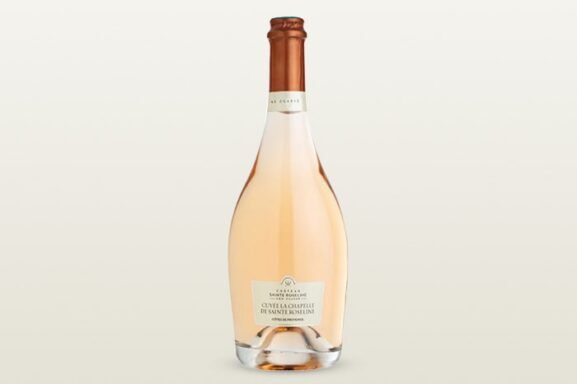Great Britain Just Had Its Largest Ever Wine Vintage
The 2023 season has been declared a “miracle harvest” in Great Britain with a whopping estimated 20 to 22 million bottles of wine in production. It was the nation’s largest vintage on record by a long shot—a 50% increase from its previous record in 2018, when 13.1 million bottles of wine were produced.
This staggering growth—which will bring more of the nation’s renowned traditional-method sparklers to market—was made possible by several factors including weather and expanding acreage in planted vineyards.
In a climate as variable as Great Britain’s, yields are unpredictable. Last summer was marked by lots of gray skies and rain, but it also offered up a frost-free spring and a warm autumn. Paired with an increase in technological investments like machine harvesters, which helped ramp up production speed, these favorable conditions enabled growers to pick 30,000 tons of grapes, or 9.6 tons to the hectare—nearly double the five tons they picked in 2022. Yields were particularly favorable for the country’s top four varieties: Chardonnay, Pinot Noir, Pinot Meunier and Bacchus (a German hybrid variety dubbed the “Sauvignon Blanc of England”).
You May Also Like: The Offbeat and Unexpected Traveler’s Wine Guide to England
But the biggest contributor to Great Britain’s production boom is the substantial increase in vine plantings. They can be traced both to domestic producers and international ones, including the Champagne houses Taittinger and Vranken Pommery and, most recently, California’s Jackson Family Wines. Over the past five years alone, United Kingdom grapevine plantings have increased by nearly 75%. There are now over 4,000 hectares (9,884 acres) under vine in the U.K., 95% of which are located in England’s south. That’s over 2,470 acres (1,000 hectares) more than what was in the ground in 2018. And this number is expected to keep growing steadily. Experts have predicted that there will be twice as many planted acres in the next decade—a prospect that has many industry insiders both excited and nervous.
“Concerningly, just as the production volume from 2023 seems likely to hit 20 million bottles, the sales estimates for the year 2022 stalled a little (after the excellent growth seen in 2021),” says master of wine Justin Howard-Sneyd, of The Hive Wine Consulting Ltd, who works with a number of English producers and buys wine for retail and restaurants. “There is a justifiable concern that production now structurally outpaces sales, and that unless sales can be accelerated quickly, this gap is going to keep growing.”
An oversupply problem is usually accompanied by price depressions, which, in a premium industry such as Great Britain’s, where most sparkling bottles retail between £25-50 ($32-64), has the potential to upend wineries’ sales plans. It could force them to turn towards lower-priced still wines like whites and rosés that can be released to market quickly. There are challenges on this front, however, in that most vineyards are planted specifically for sparkling production. Only in the warmest sites will it be possible to ripen fruit to table-wine levels (sparkling is generally picked earlier, to retain high acidity levels). That said, lower prices would mean greater accessibility.
“The good news is that more people will be able to afford a taste of English wine,” Howard-Sneyd says. It also suggests that more English wines could make their way to the United States, where only a few handfuls of producers can currently be purchased.
“I think it’s potentially a good thing because if England can’t drink all the wines itself, then producers will need to look more seriously at export markets—and that means looking very seriously at their pricing,” says consultant, writer and retailer Christy Frank, who sells English wine at her Hudson Valley, New York, shop Copake Wine Works and is a passionate spokesperson for the category. “Can they afford to sell wine [in the U.S.] at a price that the market will bear and still make money? I think the bigger producers can and will, and that’s great for the American consumer, as long as the quality remains high.”
You May Also Like: In England, Varied Soils Meet Cool-Climate Winemaking
Ronnie Sanders, founder of Vine Street Imports, which brings in three English wine labels, is less optimistic. He agrees that the drastically higher yields produced last year could mean more producers seek export partners in the U.S., bringing more English bottles to American drinkers. However, he’s concerned that U.S. consumers won’t bite. “Demand dictates pricing, and because it’s still a relatively unknown category, I don’t expect [greater availability] to drastically change prices or supply in the U.S.,” he says.
While English wine may not be at the top of mind for most Americans drinkers, Frank believes the potential increase in diversity, especially from small producers who are able to craft creative wines from a vintage where grapes are plentiful, will help bring more attention to the burgeoning industry.
“I think the diversity of what’s available is a huge selling point and one of the reasons I am so excited about the category,” she says. “My excitement is driven by a lot of the smaller producers who can most likely sell every single bottle they have locally. It’s a sliver of the industry, but it’s that knife’s edge that will drive excitement around what the rest of the country is producing at larger scale.”

Frank believes this to be true across the board, from charmat and pét-nats to German “heritage” grapes. But Great Britain’s calling card, the traditional-method bubbles that set the nation’s quality bar, are likely to garner the most attention from consumers outside the country.
“England’s signature snappy acidity offers a ‘wow’ factor that distinguishes it from other sparkling wine regions around the world,” says Sanders. And, with Champagne’s rising prices, he points out, there’s increasing space for other sparklers to find space on retail shelves and restaurants menus. “England easily enters the conversation because it piques drinkers’ curiosity as an unexpected place to find serious, distinctive wines.”
Published: January 12, 2024


